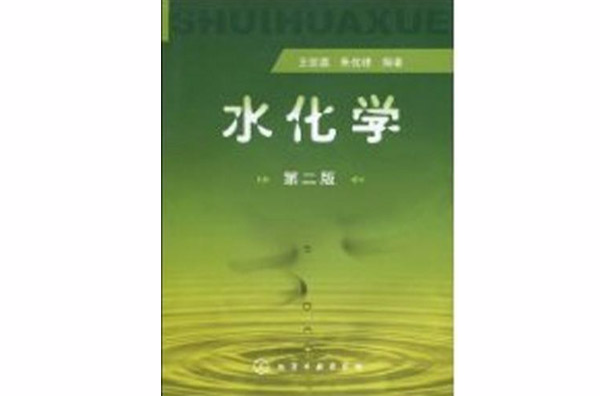概述
hydrochemistry
研究了解天然水體中各種化學因子動態規律的學科,主要是作量的描述。
延伸概念:
水產養殖水化學:研究了解養殖水體內與水生生物有關的各種化學因子動態規律的學科。
主要任務
1、水的功用:提供氧氣、提供養分、容納養殖對象的代謝廢物、傳播病害毒物、溶解分散的藥物。
2、任務:
(1)研究水體內水化成分與生產效果矛盾運動的規律。
包括研究了解水化成分與生物的關係及水化成分對生物生產的要求;
研究了解水化學因子的動態規律、分布;
研究養殖水體的水環境,並對其進行質量評估,擬定出管理對策、措施;
研究水化學的檢測方法和系統。
(3)養殖水環境化學正從定性走向定量
如研究慢性危害(低濃度)
內容簡介
《水化學(第2版)》參考了大量文獻和國內外有關教材,結合作者的研究生教學和科研工作,在保持原書內容和風格的基礎上,根據近年來水化學學科的發展充實了一些熱門話題以及新的研究成果,同時,增加了一些當今比較重要和前沿的理論和套用研究內容。
《水化學(第2版)》以化學原理為主線,較全面地介紹了水化學的基本理論及其在實踐中的套用方法與實例。全書包括緒論、化學動力學、化學平衡、酸鹼化學、配位化學、氧化還原化學、相間作用七章。書中理論深入淺出,實例豐富生動。
《水化學(第2版)》適合作為環境科學與工程專業研究生和本科生的教材,也可供環境保護、水處理、給排水、海洋、水利、水產養殖等專業的科技人員和高校師生參考。
圖書目錄
第1章 緒論 (Introduction)
1.1 水化學的意義 (The significance of water chemistry)
1.1.1 水的含義 (The meaning of water)
1.1.2 水化學的基本內容 (The basic content of water chemistry)
1.1.3 水化學的意義(The significance of water chemistry)
1.2 水的性質(The properties of water)
1.2.1 水的性質及其意義(The properties of water and their significances)
1.2.2 水的異常特性與水分子結構的關係(The relationship between unusual properties and the molecular structure of water)
1.3 天然水(Natural waters)
1.3.1 地球上水的分布(The distribution of water in the earth)
1.3.2 天然水的依數性(Colligative properties of natural water)
1.3.3 海水(Sea water)
1.3.4 雨雪水(Rain and snow water)
1.3.5 地表水和地下水(Surface water and ground water)
1.4 污水(Waste waters)
習題
第2章
化學動力學(Chemical Kinetics)
2.1 反應速率(Reaction rate)
2.2 反應機理(Reaction mechanism)
2.3 阿倫尼烏斯定理(Arrhenius law)
2.4 催化作用(Catalysis)
2.4.1 催化作用概述(Introduction of catalysis)
2.4.2 催化作用套用實例(Application examples of catalysis)
2.4.3 沸石(Zeolite)
2.5 經驗速率方程(Empirical rate law)
2.5.1 有機物生物氧化降解反應的經驗速率方程(The empirical rate equation for BOD)
2.5.2 細菌增殖的經驗速率方程(The empirical rate equation for microbial growth)
習題
第3章
化學平衡(Chemical Equilibrium)
3.1 化學平衡的動力學本質(The dynamic nature of chemical equilibrium)
3.2 熱力學基礎(The thermodynamic basis)
3.2.1 利用吉布斯自由能判別反應方向(Determine reaction direction by Gibbs free energy)
3.2.2 范特霍夫公式(Vant Hoff equation)
3.3 水溶液中離子和分子的非理想行為(Nonideal behavior of ions and molecules in solution)
3.3.1 離子的非理想行為(Nonideal behavior of ions)
3.3.2 分子的非理想行為(Nonideal behavior of molecules)
3.4 化學平衡計算(Chemical equilibrium calculation)
習題
第4章
酸鹼化學(Acid?Base Chemistry)
4.1 酸鹼化學基礎 (The basis of acid base chemistry)
4.2 平衡計算(Equilibrium calculation)
4.2.1 質子轉移關係式(Proton condition)
4.2.2 酸鹼平衡計算實例(Examples of acid?base equilibrium calculation)
4.3 pc~pH圖和α~pH圖(The pc~pH diagrams and α~pH diagrams)
4.3.1 一元酸?共軛鹼體系的pc~pH圖(The pc~pH diagrams of monoprotic acid conjugate base systems)
4.3.2 多元酸?共軛鹼體系的pc~pH圖(The pc~pH diagrams of polyprotic acid conjugate base systems)
4.3.3 α~pH圖(α~pH diagrams)
4.4 pH緩衝溶液和緩衝強度(pH buffers and buffer intensity)
4.4.1 pH緩衝溶液(pH buffers)
4.4.2 緩衝強度(Buffer intensity)
4.5 碳酸鹽系統(The carbonate system)
4.5.1 碳酸鹽系統的平衡關係(Equilibria in the carbonate system)
4.5.2 碳酸鹽物種濃度的計算(Calculation of carbonate species concentrations)
4.5.3 鹼度和酸度(Alkalinity and acidity)
4.6 酸鹼化學在水處理中的套用(Water treatment applications of acid?base chemistry)
4.7 全球碳循環(Global carbon cycle)
4.7.1 概述(Introduction)
4.7.2 大氣CO2含量(COconcentration in the atmosphere)
4.7.3 陸地生態系統反饋(Feedback of terrestrial ecology)
4.7.4 海洋反饋(Oceanic feedback)
4.7.5 固碳對策與研究展望(Ways of carbon fixation and future carbon cycle study)
習題
第5章
配位化學(Coordination Chemistry)
5.1 配位化學基礎(The basis of coordination chemistry)
5.1.1 基本術語(Basic terms)
5.1.2 配合物化學鍵理論(Chemical bond theory of complexes)
5.1.3 配合物的穩定性(Complex stability)
5.1.4 反應速率(Reaction rate)
5.2 平衡計算(Equilibrium calculation)
5.3 金屬(Metals)
5.3.1 銅在水與廢水中的行為(The behavior of copper in water and wastewater)
5.3.2 金屬的形態分析(Species analysis of metals)
5.3.3 金屬離子的水解——以H2O和OH-為配位體(Hydrolysis of metal ions——H2O and OH- as ligands)
5.3.4 無機高分子絮凝劑(Inorganic polymer flocculatants)
5.4 腐殖質(Humic substances)
5.4.1 腐殖質成分、性質與結構(Characteristics of humic substances)
5.4.2 腐殖質與金屬離子的螯合(Chelation between humic substances and metals)
5.4.3 富里酸與胡敏酸的分離技術(Isolation of fulvic acid and humic acid)
習題
第6章
氧化還原化學(Oxidation and Reduction Chemistry)
6.1 氧化還原化學基礎(The basis of oxidation and reduction chemistry)
6.1.1 氧化還原反應的化學計量關係(Redox stoichiometry)
6.1.2 氧化還原平衡(Redox equilibrium)
6.2 氧化還原平衡的圖解表示(Graphical representation of redox equilibrium)1
6.2.1 pc~pε圖(pc~pε diagrams)1
6.2.2 pε~pH圖(pε~pH diagrams)1
6.2.3 有固體存在時的pε~pH圖(The pε~pH diagram incorporating solids)
6.2.4 天然水的pε值,決定電位(The pε value of natural water,determining potential)
6.3 電化學腐蝕(Electrochemical corrosion)
6.3.1 腐蝕電池(Corrosion cell)
6.3.2 濃差電池(Concentration cell)
6.3.3 腐蝕的控制(Corrosion control)
6.4 鐵化學(Iron chemistry)
6.4.1 天然水中鐵的來源和存在狀態(The sources and status of iron in natural water)
6.4.2 地下水中的鐵(Iron in groundwaters)
6.4.3 酸性礦排水(Acid mine drainage)
6.5 氯化學(Chlorine chemistry)
6.5.1 概述(Introduction)
6.5.2 折點氯化(Breakpoint chlorination)
6.5.3 氯與有機物反應形成的有害副產物(The hazardous by?products of chlorine reactions with organic substances)
6.6 氮化學(Nitrogen chemistry)
6.6.1 氮循環(The nitrogen cycle)
6.6.2 水中含氮物種的氧化還原轉化(Redox transformation of nitrogen species in water)
6.6.3 氮的微生物轉化(Microbial transformation of nitrogen)
6.7 高級氧化過程(Advanced oxidation processes,AOPs)
6.7.1 概述(Introduction)
6.7.2 臭氧高級氧化技術(Ozonation technology)
習題
第7章
相間作用(Phase Interactions)
7.1 表面張力與表面自由能(Surface tension and surface free energy)
7.2 氣體在水中的溶解與揮發(Dissolution and volatilization of gases in water)
7.2.1 亨利定律(Henry slaw)
7.2.2 氣體在水中的溶解速率(Dissolution rate of gases in water)
7.2.3 溶解氧(Dissolved oxygen)
7.3 固體的沉澱與溶解(Precipitation and dissolution of solids)
7.3.1 沉澱與溶解動力學(Precipitation and dissolution kinetics)
7.3.2 沉澱與溶解的平衡計算(Equilibrium calculation of precipitation and dissolution)
7.3.3 碳酸鈣的溶解度與水質穩定性(Calcium carbonate solubility and water stability)
7.3.4 磷酸鹽化學(Phosphate chemistry)
7.4 固體表面吸持 (Sorption of solids)
7.4.1 吸附作用(Adsorption)
7.4.2 分配作用(Partition)
7.4.3 生物富集(Bio?accumulation)
7.5 沉積物(Sediments)
7.5.1 沉積物的形成(Formation of sediments)
7.5.2 膠體微粒的聚沉(Aggregation of colloidal particles)
7.5.3 微生物絮凝劑(Microbial flocculatants)
7.5.4 絮凝動力學(Flocculation kinetics)
7.5.5 水體底泥中微量金屬分析的分段提取技術及其套用(Sequential extraction technique for trace metals analyses in aquatic sediments and its application)
7.5.6 洪水對河流底泥有機污染物分布的影響(Impact of flood on distribution of orgnic pollutants in river sediment)
7.6 持久性有機污染物(Persistent organic pollutants, POPs)
7.6.1 持久性有機污染物的界面行為(Phase interactions of persistent organic pollutants)
7.6.2 水中有機污染物的分析方法(Analytical methods for organic pollutants in water)
7.7 膜化學(Film and membrane chemistry)
7.7.1 界面膜(Interfacial film)
7.7.2 膜分離(Membrane separation)
習題
附錄
附錄1 地表水環境質量標準
附錄2 地下水質量標準
附錄3 海水水質標準
附錄4 生活飲用水衛生標準
附錄5 景觀娛樂用水質標準
附錄6 農田灌溉水質標準
附錄7 漁業水質標準
附錄8 飲用天然礦泉水標準
附錄9 污水綜合排放標準
參考文獻

